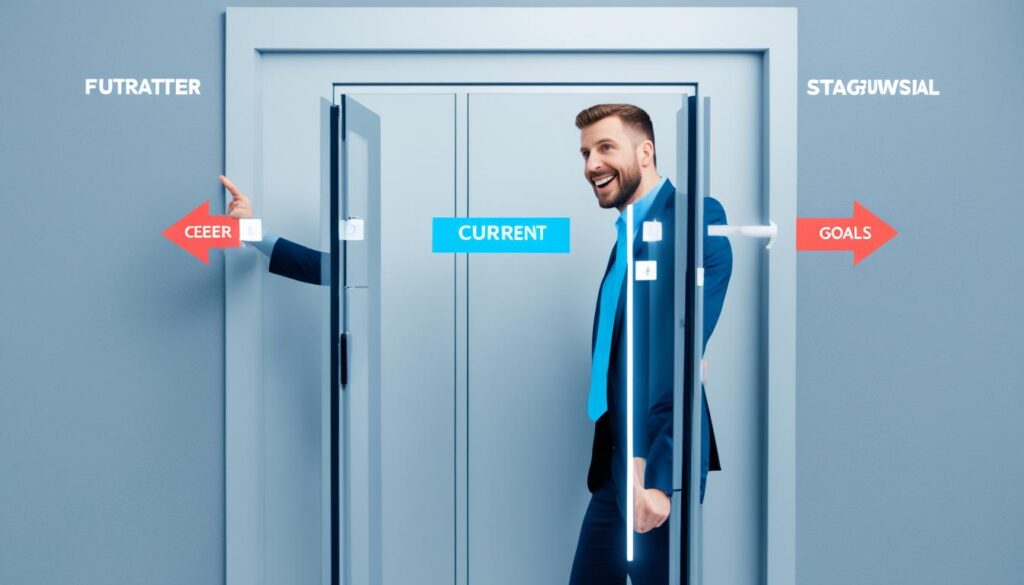Elevate Your Career with Performance Goals Examples

Are you feeling stuck in your professional life, unsure of how to advance your career? Do you long for clarity, motivation, and measurable progress? The key to unlocking your full potential lies in setting performance goals.
Setting professional goals is not just a box to check off; it is a transformative practice that can propel your career to new heights. Whether you want to enhance your leadership skills, become a mentee or mentor, earn a professional certification, or improve your public speaking abilities, performance goals provide the roadmap for success.
In this article, we will explore the importance of professional goals, the steps to effective goal-setting, and provide you with concrete examples to inspire your own aspirations. Discover how defining your goals can help you navigate the complexities of the professional world and unlock a world of opportunities.
Key Takeaways:
- Setting professional goals is crucial for sustained growth and career advancement.
- Professional goals provide clarity, motivation, and measurable progress.
- Examples of professional goals include enhancing public speaking skills, becoming a mentee or mentor, earning a professional certification, and improving leadership skills.
- Effective goal-setting involves self-reflection, aligning goals with personal values, using the SMART framework, embracing continuous learning and adaptability, and seeking support and guidance.
- Career goals are important to potential and current employers as they provide insight into your career vision and how well it aligns with the company’s needs.
Why Professional Goals are Essential for Career Growth
Professional goals play a crucial role in your career growth and development. They provide you with clarity and direction, serving as a roadmap for achieving success in your chosen profession. By setting performance goals and embracing professional development goals, you can unlock your true potential and elevate your career to new heights.
One of the key benefits of setting professional goals is that they keep you motivated and driven to take action. They provide a sense of purpose and direction in your professional life, fueling your ambition and determination to succeed. Whether it’s improving your skills, advancing in your current role, or transitioning to a new industry, professional goals serve as a constant reminder of what you want to achieve.
Furthermore, professional goals allow you to measure your progress and identify areas for improvement. By clearly defining your objectives, you can track your accomplishments and assess your growth over time. This self-reflection enables you to identify strengths to leverage and weaknesses to address, helping you continuously develop and enhance your professional skillset.
Professional goals can be categorized into short-term and long-term aspirations. Short-term goals are focused on immediate achievements, providing tangible outcomes that boost your confidence and propel you forward. On the other hand, long-term goals are more visionary and set the trajectory for your career path, aligning your actions with your overall career aspirations.
Setting performance goals and professional development goals are common practices across various industries. From technology and finance to healthcare and marketing, professionals from all walks of life recognize the value of having clear, actionable objectives. With professional goals, you can ensure that you are on the right path towards success, and you are working towards achieving the outcomes you desire.
Embrace the power of setting professional goals and witness the transformative impact it can have on your career growth. With a clear vision and focused action, you can turn your aspirations into reality and become the best version of yourself.
Benefits of Setting Professional Goals:
- Clarity and direction in your career
- Motivation and drive to take action
- Measuring progress and identifying areas for improvement
- Short-term accomplishments and long-term aspirations
- Alignment with overall career aspirations
- Universal relevance across various industries
| Short-Term Goals | Long-Term Goals |
|---|---|
| Immediate achievements | Visionary aspirations |
| Boost confidence | Set career trajectory |
| Tangible outcomes | Align actions with aspirations |
The 5 Steps to Effective Goal-Setting
Setting goals is crucial for personal growth and career development. But setting goals without a clear plan and framework can often lead to frustration and lack of progress. To ensure your goals are SMART (specific, measurable, achievable, relevant, time-bound) and aligned with your individual performance goals, follow these five steps:
- Reflect on Your Values and Aspirations
- Align Goals with Personal Values
- Utilize the SMART Framework
- Embrace Continuous Learning and Adaptability
- Seek Support and Guidance
Step 1: Reflect on Your Values and Aspirations
Before setting any goals, take the time to reflect on your values and aspirations. Consider what truly matters to you in your personal and professional life. Understanding your core values will help ensure that your goals are meaningful and in line with your authentic self.
Step 2: Align Goals with Personal Values
Once you have identified your values, align your goals with them. This step will ensure that your goals are genuinely important to you and will provide the motivation and drive to achieve them. When your goals align with your values, you are more likely to stay committed and focused.
Step 3: Utilize the SMART Framework
The SMART framework is a valuable tool for setting goals that are specific, measurable, achievable, relevant, and time-bound. By following this framework, you can create goals that are clear, concise, and have a set timeline for completion. Here’s an example of how to apply the SMART framework:
| SMART Element | Example |
|---|---|
| Specific | Improve public speaking skills by attending a Toastmasters course. |
| Measurable | Deliver at least three successful presentations within the next six months. |
| Achievable | Allocate time each week for practice and attend Toastmasters meetings regularly. |
| Relevant | Enhancing public speaking skills will contribute to my career advancement and leadership development. |
| Time-Bound | Complete the Toastmasters course and achieve the set goals within six months. |
Step 4: Embrace Continuous Learning and Adaptability
Successful goal-setting involves a mindset of continuous learning and adaptability. Be open to gaining new knowledge, acquiring additional skills, and adjusting your goals as needed. Embracing a growth mindset will enable you to overcome challenges and make the necessary changes to stay on track.
Step 5: Seek Support and Guidance
Don’t be afraid to seek support and guidance on your goal-setting journey. Reach out to mentors, coaches, or trusted colleagues who can provide insights, advice, and accountability. Collaborating with others can help you gain different perspectives and stay motivated throughout the process.
By implementing these five steps, you can set clear and achievable goals that will guide your career trajectory and contribute to your individual performance goals. Remember, effective goal-setting is a continuous process that requires self-reflection, alignment with personal values, and commitment to the SMART framework.

10 Examples of Professional Goals
Setting employee performance goals is crucial for professional development and career advancement. Here are 10 examples of measurable goals that can contribute to your growth and success:
- Enhancing public speaking skills: Join a Toastmasters club to improve your communication and presentation abilities.
- Becoming a mentee or mentor: Seek opportunities to learn from experienced professionals or mentor someone in your field.
- Earning a professional certification: Obtain a certification relevant to your industry to demonstrate your expertise and enhance your credentials.
- Improving leadership skills: Take on a leadership role in a project or team to develop your leadership abilities.
- Expanding professional network: Attend industry conferences and networking events to connect with colleagues and industry influencers.
- Taking on leadership responsibilities: Volunteer for leadership roles within professional organizations or community projects.
- Broadening skill set: Acquire new skills outside your current expertise to diversify your abilities and stay competitive.
- Setting measurable performance goals: Establish specific targets for key performance indicators that align with organizational objectives.
- Embracing continuous learning: Invest time in self-education through books, online courses, or workshops.
- Developing a professional development plan: Create a roadmap outlining your short-term and long-term goals and the steps needed to achieve them.
By setting and pursuing these professional development goals, you can elevate your career and unlock new opportunities.

How to Create a Professional Development Plan
Creating a professional development plan is the key to charting your career trajectory and realizing your full potential. By setting professional development goals, you can gain clarity on where you want to go and create a roadmap to get there. Here are the steps to help you create an effective professional development plan:
Step 1: Identify Your Values
To begin, reflect on your core values and what truly matters to you in your professional life. Consider your passions, interests, and strengths. Understanding your values will guide you in aligning your goals with what is important to you personally.
Step 2: Set Specific, Achievable, and Time-Bound Goals
Once you have identified your values, it’s time to set professional development goals that are specific, achievable, and time-bound. Specific goals provide clarity and focus, while achievable goals ensure they are within your reach. Time-bound goals establish a clear timeline for accomplishing them.
Step 3: Create Short-Term and Long-Term Goals
A balanced professional development plan includes both short-term and long-term goals. Short-term goals are your stepping stones towards long-term success. They allow you to make progress and experience a sense of achievement along the way. Long-term goals provide a vision for your future and serve as a guide for your overall career direction.
Step 4: Regularly Evaluate and Adjust
It’s essential to regularly evaluate your progress and make adjustments to your professional development plan as needed. Reflect on the goals you have set and determine if they are still aligned with your values and career aspirations. Adaptability is key to staying on track and ensuring your plan remains relevant and effective.
Remember, creating a professional development plan is a dynamic process. It requires self-reflection, goal setting, and regular evaluation. By following these steps, you can create a roadmap to success and propel your career forward.

| Benefits of Creating a Professional Development Plan |
|---|
| 1. Gain clarity on your career direction |
| 2. Increase motivation and drive to succeed |
| 3. Focus on personal and professional growth |
| 4. Develop new skills and enhance existing ones |
| 5. Gain a competitive edge in the job market |
Why Career Goals Matter to Potential and Current Employers
Career goals play a vital role in shaping your professional journey and are highly significant to both potential and current employers. These goals provide valuable insight into your career vision and demonstrate how well it aligns with the needs and objectives of the company.
For potential employers, your career goals showcase your level of ambition, motivation, and dedication. They allow employers to see if your aspirations align with the company’s mission and long-term objectives. By discussing your career goals during interviews, you can convey your passion and enthusiasm for the industry and position yourself as a valuable asset.

Current employers are equally invested in your career goals. As they have been supporting your professional development, they have a vested interest in helping you move closer to achieving your goals. Sharing your goals with your current employer demonstrates your commitment to personal growth and shows that you are proactive in taking steps to enhance your skills and contribute more effectively to the organization.
During performance reviews, discussing your short-term and long-term career goals is crucial. It allows your employer to understand your aspirations and consider how they can support your growth within the company. By aligning your goals with the organization’s objectives, you can position yourself as an invaluable asset and increase your chances of career advancement.
When discussing your career goals, it is essential to outline the steps you are taking to achieve them. This can include ongoing education, training programs, networking initiatives, or pursuing additional certifications. By showcasing your commitment to continuous learning and development, you demonstrate your dedication to personal and professional growth.
Benefits of Discussing Career Goals with Employers:
- Aligns your aspirations with company objectives.
- Demonstrates ambition, motivation, and dedication.
- Highlights your commitment to personal and professional growth.
- Increases your chances of career advancement.
- Showcases your proactive approach to skill development.
Sample Career Development Goals:
| Short-Term Goals | Long-Term Goals |
|---|---|
| Complete a professional certification within the next six months. | Attain a leadership position within the organization in the next three years. |
| Improve public speaking skills through a Toastmasters course. | Establish a consulting firm and become a recognized industry expert. |
| Expand professional network by attending industry conferences and events. | Start a nonprofit organization focused on providing education to underprivileged children. |
Discussing your career goals with potential and current employers helps establish a clear roadmap for your professional success. By aligning your aspirations with company objectives and demonstrating your dedication to growth and development, you can position yourself as a valuable asset and open doors to exciting opportunities.
Conclusion
Setting professional goals is crucial for your career growth and personal development. With the right approach to goal-setting and the utilization of performance goal examples, you have the power to elevate your career and unlock your full potential.
Remember, it’s important to align your career goals with your values. By doing so, you can ensure that your aspirations are in line with your core beliefs and motivations, providing you with a sense of purpose and fulfillment along the way.
In addition, embrace continuous learning as you work towards your goals. The professional world is constantly evolving, and by staying curious and open-minded, you can adapt to new challenges and opportunities, fostering both personal and professional growth.
Lastly, don’t hesitate to seek support and guidance throughout your journey. Whether it’s through mentorship, networking, or professional development programs, surrounding yourself with like-minded individuals who can provide insights and advice can make a significant difference in your career trajectory.






